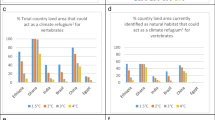Summary
The vegetation of the Mediterranean Basin was originally composed of evergreen forests; during the Pleistocene deciduous forests expanded, chiefly in the mountains. In historical time the forest belt was strongly reduced by human activity and substituted by anthropogenous vegetation types (macchia, garigue, weed-communities). The frequency of polyploids in the present vegetation types support this interpretation. Reciprocal relationships between the vegetational system and social system are discussed and a terminology is proposed. During ancient times and the middle ages a reciprocal control of vegetation and human activity was possible (cyclic system), stabilizing the vegetation in a steady state; the technological impact modified these conditions in a linear sense, and now the vegetation is menaced by irreversible changes.
Zusammenfassung
Die Vegetation der Mittelmeerländer bestand ursprünglich aus immergrünen Hartlaubwäldern; während des Pleistozäns breiteten sich sommergrüne Laubwälder aus, besonders in den gebirgigen Teilen. Die dichtere menschliche Besiedlung nach der Steinzeit bewirkte eine Einschränkung des Waldgürtels der zum Grossteil durch anthropogene Vegetationstypen (Macchie, Garigue, Unkrautgemeinschaften) ersetzt wurde. Die Spuren dieses Prozesses spiegeln sich in den Polyploidieverhältnissen. Bis zu diesem Punkt entwickelte sich das vegetationelle System autonom. Mit dem Auftreten des Menschen beginnt eine rege Dialektik zwischen dem vegetationellen und dem sozialen System. Einige Gesetzmässigkeiten werden dargestellt und eine geeignete Terminologie wird vorgeschlagen. Während des Altertums und des Mittelalters war eine gegenscitige Kontrolle zwischen Vegetation und menschliche Einwirkung möglich (zyklisches System), und die Vegetation wurde dadurch in einem Zustand von Fliessgleichgewicht stabilisiert; durch die Technologie wurden diese Verhältnisse verändert und es entstand ein lineares System, sodass nun die Vegetation unter der Drohung einer irreversiblen Aenderung steht.
Similar content being viewed by others
References
Bharucha, F.R. 1933. Etude écologique et phytosociologique de l'association à Brachypodium ramosum et Phlomis lychnitis des Garigues languedociennes. Beih. Bot. Centralbl. II, 50: 247–239.
Bolos, O. & R. Molinier. 1958. Recherches phytosociologiques dans l'Ille de Majorque. Collect. Bot. 5: 699–865.
Braun-Blanquet, J. 1923. L'origine et le développement des Flores dans le Massif Central de France. ed. Lhomme-Beer, Paris, Zürich.
Braun-Blanquet, J. 1933. L'association végétale climatique et le climax du sol dans le Midi méditerranéen. Bull. Soc. Bot. Fr. 80: 715–722.
Braun-Blanquet, J. 1936. La forêt d'Yeuse languedocienne (Quercion ilicis). Monographie phytosociologique. Mem. Soc. Etude Sc. Nat. Nimes 5: 1–147.
Davis, P.H., Harper, P.C. & I.C. Hedge. 1971. Plant life of South-West Asia. Oliver & Boyd, Edinburgh. 335 pp.
Di Castri, F. & H.A. Mooney. 1973. Mediterrancan type ecosystems. Springer, Berlin, Heidelberg, New York. 405 pp.
Dickinson, O. 1934. Les espèces survivantes tertiaires du Bas-Languedoc. Comm. SIGMA no 34. Toulouse.
Di Martino, A., Marcenò C. & F.M. Raimondo (in press). Sintesi degli studi condotti sulla vegetazione delle Madonie.
Emiliani, C. 1955. Pleistocene temperatures. J. Geol. 63: 538–578.
Feoli, E., Lausi, D. & S. Pignatti, 1975. Grundsätze einer Kausalen Erforschung der Vegetationsdynamik. In W. Schmidt: Sukzessionsforschung, pp. 1–12. J. Cramer, Vaduz.
Frobenius, L. 1933. Kulturgeschichte Afrikas Phaidon, Zürich. 652 pp.
Gamisans J. 1975. La végétation des montagnes Corses. Thèse Univ. Marseille. 295 pp.
Lang, G., 1970. Florengeschichte und mediterran-mitteleuropäisch Florenbezichungen. Feddes Rep. 81: 315–335.
Mai, D.H. 1965. Der Florenwechsel im jüngeren Tertiär Mitteleuropas. Feddes Rep. 70: 157–169.
Meusel, H. 1970. Wuchsformenreihen mediterran-mitteleuropäischer Angiospermen-Taxa. Feddes Rep. 81: 315–335.
Pasa, A 1953. Appunti geologici per la paleogeografla della Puglia. Mem. Biogeogr. Adriat. 2: 175–286.
Pignatti, S. 1960. II significato delle specie poliploidi nelle associazioni vegetali. Atti Ist. Ven. Sc. Lett. Arti 118: 75–98.
Pignatti, S. 1978. Flora d'Italia. Cramer. Vaduz. C. 1300 pp.
Pignatti, S. In press. Plant geographical and morphological evidences in the evolution of the mediterranean flora. Webbia.
Prigogine, I. 1967. Thermodynamics of irreversible processes. Wiley, New York, London, Sydney. 147 pp.
Raven, P.H. 1973. The evolution of mediterranean Floras in: Di Castri F. & H.A. Mooney (cit.) p. 213–224.
Rikll, M. 1942–1948. Das Pflanzenkleid der Mittelmeerländer, 3 vol. H. Huber, Bern, 1418 pp.
Termier, H. & G. Fermier 1960. Atlas de Paleogeographie. Masson, Paris, 100 pp.
Volterra, V. 1931. Lecons sur la théorie mathématique de la lutte pour la vie. Gauthier-Villars, 146 pp. Paris.
Author information
Authors and Affiliations
Additional information
Nomenclature follows Pignatti (1978).
Contribution to the Symposium on Plant species and plant communities, held at Nijmegen, 11–12 November 1976, on the occasion of the 60th birthday of Professor Victor Westhoff.
Rights and permissions
About this article
Cite this article
Pignatti, S. Evolutionary trends in Mediterranean flora and vegetation. Vegetatio 37, 175–185 (1978). https://doi.org/10.1007/BF00717651
Accepted:
Issue Date:
DOI: https://doi.org/10.1007/BF00717651




